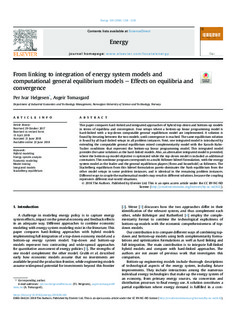| dc.contributor.author | Helgesen, Per Ivar | |
| dc.contributor.author | Tomasgard, Asgeir | |
| dc.date.accessioned | 2019-01-04T12:24:16Z | |
| dc.date.available | 2019-01-04T12:24:16Z | |
| dc.date.created | 2018-10-12T11:02:50Z | |
| dc.date.issued | 2018 | |
| dc.identifier.citation | Energy. 2018, 159 1218-1233. | nb_NO |
| dc.identifier.issn | 0360-5442 | |
| dc.identifier.uri | http://hdl.handle.net/11250/2579213 | |
| dc.description.abstract | This paper compares hard-linked and integrated approaches of hybrid top-down and bottom-up models in terms of equilibria and convergence. Four setups where a bottom-up linear programming model is hard-linked with a top-down computable general equilibrium model are implemented. A solution is found by iterating between the two models, until convergence is reached. The same equilibrium solution is found by all hard-linked setups in all problem instances. Next, one integrated model is introduced by extending the computable general equilibrium mixed complementarity model with the Karush-Kuhn-Tucker conditions that represent the bottom-up linear programming model. This integrated model provides the same solutions as the hard-linked models. Also, an alternative integrated model is provided, where the bottom-up model objective is optimized while the top-down model is included as additional constraints. This nonlinear program corresponds to a multi-follower bilevel formulation, with the energy system model as the leader and the general equilibrium players (firms and household) as followers. The Stackelberg equilibrium from this bilevel formulation pareto-dominates the Nash equilibrium from the other model setups in some problem instances, and is identical in the remaining problem instances. Different ways to couple the mathematical models may result in different solutions, because the coupling represents different real-world situations. | nb_NO |
| dc.language.iso | eng | nb_NO |
| dc.publisher | Elsevier | nb_NO |
| dc.rights | Attribution-NonCommercial-NoDerivatives 4.0 Internasjonal | * |
| dc.rights.uri | http://creativecommons.org/licenses/by-nc-nd/4.0/deed.no | * |
| dc.title | From linking to integration of energy system models and computational general equilibrium models - Effects on equilibria and convergence | nb_NO |
| dc.type | Journal article | nb_NO |
| dc.type | Peer reviewed | nb_NO |
| dc.description.version | publishedVersion | nb_NO |
| dc.source.pagenumber | 1218-1233 | nb_NO |
| dc.source.volume | 159 | nb_NO |
| dc.source.journal | Energy | nb_NO |
| dc.identifier.doi | 10.1016/j.energy.2018.06.146 | |
| dc.identifier.cristin | 1619929 | |
| dc.relation.project | Norges forskningsråd: 209697 | nb_NO |
| dc.description.localcode | © 2018 The Authors. Published by Elsevier Ltd. This is an open access article under the CC BY-NC-ND license (http://creativecommons.org/licenses/by-nc-nd/4.0/). | nb_NO |
| cristin.unitcode | 194,60,25,0 | |
| cristin.unitname | Institutt for industriell økonomi og teknologiledelse | |
| cristin.ispublished | true | |
| cristin.fulltext | original | |
| cristin.qualitycode | 2 | |

